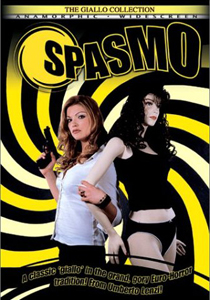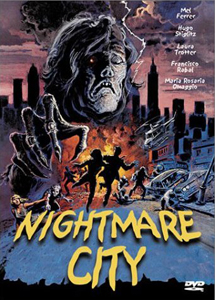I figured that April would be
Grindhouse month, but mainstream audiences proved that’s not the case, and the
Weinstein Co’s beancounters agree. Still, if you loved the film there might be
a temptation to dig up some of the original films referenced so thoroughly by
Rodriguez and Tarantino. And digging through the grindhouse archives means that
sooner or later, you’re going to go home with a movie by Umberto Lenzi.
Jeremy ‘Mr. Beaks’ Smith referenced Lenzi in his excellent Grindhouse
review. What you didn’t see in that piece was a missing reel paragraph
ridiculing Lenzi’s most commonly known film, Nightmare City. Not
to worry, Jeremy, I’ve got the trash talk covered here. With a little love
thrown in, too.
name that should inspire tremors of uncertainty. Bringing home a new Lenzi
flick is like picking up a girl with a bag over her head…you might unwrap a
Miss America stunner or a wildebeest. Or a wildebeest with poorly painted
makeup, decaying latex and visible hair netting. That’s more likely. Yeah, this
whole paragraph is sexist. But this is exploitation! Gotta set the mood.
 Lenzi is famous for a
Lenzi is famous for a
couple of entries in the cannibal genre (like Cannibal Ferox, aka
Make Them Die Slowly, and Eaten Alive) but had his
hand in nearly every other pop movie mode between the ’60s and ’80s: spy
pictures, horror, giallo and crime. He claims to have invented the Italian
thriller with Orgasmo in 1969, which is patently absurd — there
was this guy named Mario Bava before him — and he hardly defined it as Dario
Argento did a year later with The Bird With The Crystal Plumage.
and skewed viewpoints are appropriate to his films. Looking at your average
Lenzi movie is like verifying your own appearance in a melting mirror. Nothing
feels right. People don’t behave like people, character is a distant
afterthought and physical laws might keep car tires planted on the ground, but
they don’t have any command over time and space. These movies either reveal the
process of a mind that is magnificently childlike in its lack of morality and
motivation, or truly deranged for exactly the same reasons.
average output, not
distinction between Lenzi’s inability to portray reality (or any version
thereof) and Lucio Fulci’s disinterest in doing so. Crucially, Lenzi almost
always lacks style, the presence of which in Fulci’s films lends a lot of
credence to his otherwise adrift stories. Watch any Lenzi horror movie and then
watch The Beyond, and the importance of style is obvious. And if
you haven’t watched The Beyond, why not? It’s glorious, and does face melting
as well as Spielberg.
 Let’s start with Seven
Let’s start with Seven
Blood Stained Orchids, possibly one of the most unremarkable gialli in
existence. That is, once you factor out the attractive presences of Marisa Mell
(Danger: Diabolik) and Uschi Glas, in her single thriller
appearance most notable Italian appearance. Almost doggedly foregoing the visceral zeal with which Argento
dispatched females in his thrillers, Lenzi coughs up a list of seven women
about to get the axe. They’re nominally linked through their presence at a
resort hotel one fall, and more diabolically linked through the determination
with which a black-gloved pair of hands seeks to do them in.
justifiably revered for being hotbeds of experimentation, whether in content
(gore and sexual transgression), visual style or sound design. Orchids
boasts none of those indulgences. Riz Ortolani’s music is entertaining, but
there’s no theme strong enough to carry an audience through the interminably
long segments in which lead Antonio Sabato drives around looking for clues. The
set pieces are largely non-existent and the photography flat and drained of all
tension.
is tame and even yawn-inducing, relying only on nudity (not featuring Glas or Mel)
in the first act to keep the guys watching. In the long run, Uschi Glas makes
for a refined giallo heroine, in part because her perfectly sculptured hair is
so meticulously maintained. She’s never a mess. But that doesn’t make for very
interesting viewing, and even when she’s set up as bait for the elusive killer,
you won’t be held in suspense.
almost any typical form of Giallo titillation, the most damaging void in Orchids
is ideological. Lenzi’s most common theme is a distaste for the
lifestyle of the elite, and while that shows up dramatically in the two movies
I’ll talk about next, it’s barely a shadow here. The argument could be made
that Sabato’s mostly ineffectual ‘heroic’ presence is commentary enough (he’s a
famous and wealthy fashion designer) but since he doesn’t croak, I don’t buy
it. Beyond ‘hey, I like FPS killing!’ this movie has nothing
to say.
 Two years later,
Two years later,
Lenzi would improve his cred slightly with Spasmo, which if not
nearly as sick as the title implies, at least keeps us off balance. Not only
does it string along a subjectively paranoid story in which the hero constantly
doubts his perceptions, it uses a strange sub-motif of violence against
mannequins to set an uneasy tone.
with a lady friend on the beach, Christian (Robert Hoffman) finds a woman
seemingly washed up dead on the sand. Barbara (Suzy Kendall) is actually alive,
and (to him) kind of sexy, so he tracks her to her boyfriend’s yacht and soon
the pair are hightailing it to her hotel. There, a man intrudes upon them and
is supposedly killed by Christian. That sets off a cat and mouse game of
murder, assumed identities, deceit and (not nearly enough) sex.
like a lot about Spasmo, which is the way Lenzi just breezes right through the
relationship between Christian and Barbara. It’s initially a one-night stand,
but Christian’s instability and Barbara’s apparent vulnerability merge to
create a co-dependent relationship that is almost a metaphor for something
larger
Here Lenzi’s distaste for the rich
gets more room to grow. Most of the film takes place in decadent, daylit
resorts and residences, where idle elites have the time and money to contrive
plots against one another. Eventually, we’re even told that the evil permeating
the film isn’t just located within the elite, but potentially stains the entire
class.
walks away from another woman without a word to begin a mercurial, meaningless
union with someone else, who might just be after him for his money.
George Romero was hired to shoot several minutes of gore to fill out the murder
scenes, which are mostly presented in one big flashback at the end. That
footage isn’t in the current DVD, or anywhere else I’ve been able to find.
Lenzi, in a supplemental interview, decries Romero for his involvement. I can
understand his point of view, but goddamn – extra Romero gore is extra Romero
gore, and I’ll never stop trying to track that stuff down.
pissed because he knows his movie is pretty tepid without the gore. Sure,
there’s an air of unpredictability to the storyline, but that’s due as much to
the fact that it makes no objective sense — the reveal of the mannequin
subplot throws all continuity to the wind — as to his ability to conjure up
the core of uncertainty within all of us.
 So far you’re
So far you’re
thinking that Lenzi isn’t much worth consideration, but then, just maybe,
you’ll happen upon Almost Human. A crime flick in the very
classic Poliziotteschi mold, this is one of his best movies, and actually a
sick hardcore crime movie in general. Lenzi was at his best working on
euro-crime, and looking at Almost Human, you’d think the movie’s title
might even apply to Lenzi after all.
playing Giulio Sacchi, a cowardly sociopath who smothers his insecurities with
a full metal jacket. How’s that for a tagline? After being scorned by his
fellow gang members for panicking during a heist, Giulio concocts a scheme to
make half a billion Lire by ransoming a wealthy industrialist’s daughter. As
the scheme gathers momentum, he sheds all humanity, killing first impulsively,
then willfully and finally massacring nearly everyone he touches.
the camp bent that marked some of his comic and western roles, is nonetheless
as frightening a criminal here as you’ll find in the genre. He begins as a
simple empowered goof, much like Michael Moriarty in Q, but
sprints away from normal criminal acts so quickly that you can’t help but fear
him. Moriarty’s quirks are self-serving, but Milian’s are anti-social in every
possible sense. He’s a hair’s breadth from cashing it all in.
because Milian is ferocious, but also because Lenzi shares creative duties with
screenwriter Ernesto Gastaldi and cinematographer Frederico Zanni. Gastaldi,
also a jack of all genres, was much more attuned to the quirks of humanity than
his director. And Zanni captures real atmosphere in almost every frame,
something that Lenzi would otherwise assiduously scrub away. This movie is
dirty and full of suggestive shadows.
together not only on Eaten Alive, but on some of Lenzi’s other
good crime work: Rome Armed To The Teeth and The Cynic, The
Rat and The Fist. Look forward to coverage of those in one of the next
couple columns.)
Gastaldi, this film even packs some of the sexual deviance that should be highlighted
in Lenzi’s giallo output. There’s a constant threat of rape in any kidnapping
scenario, which isn’t downplayed here. But the real sexual attack occurs in a
Bunuel-esque scene, in which Giulio and his cohorts follow their quarry into a
rich villa. The occupants are having a typical rich folks’ night at home,
enjoying drinks and innuendo. After casually offing one of the villa’s elite,
another (male) guest is given the chance to live…if he orally services Giulio.
nasty enough, but it’s Milian’s face that pushes it into dementia. They’ve
barely begun their caper, and you can see that he’s already so far gone into
his power bender that he’s ready to commit any atrocity. And he does.
16mm blow-up car chase photography, the ever-present car going over a cliff and
Henry Silva as a determined cop. Fortunately the R1 DVD has both Italian and
English dialogue tracks, so you can listen to Milian’s original lines on the
Italian track and switch over for Silva’s dubbing of his own lines on the
other. Great stuff.
 With at least one
With at least one
honestly decent movie out of the way, I can finally get to
people have heard of, and it’s one of the worst zombie films in existence,
which means that with a group of people it’s a fantastic way to kill 90
minutes.
starring alien invaders. Not a single frame of film is soiled by anything that
could be called human experience or response. It’s entertaining in the most
mind-altering way, because for ninety minutes you’ll try to figure out how
everything common to the lives of earthbound life has been stripped from the
film. You might even be tempted to call Lenzi a superb director; certainly even
Gilliam, Bunuel or Lynch never created such a fully formed alternate existence.
plane carrying a nuclear scientist makes an unscheduled landing at a big city
airport. Met by the Civil Defense Force, the hatch doors spew out fast moving
humans infected with latex and cake makeup. These Radioactive Face Zombies
(their makeup never goes below the jawline, except to occasionally affect the
hands) also spontaneously grow knives and hatchets, with which they quickly lay
waste to a bunch of guys carrying machine guns. I guess a Radioactive Face
Zombie can bring a knife to a gun fight. There’s an exception to every rule.
to the entire city, Lenzi’s directorial skills are demonstrably less developed
than a two month fetus. He doesn’t seem to care that Mexican main man Hugo
Stiglitz is barely coasting through his scenes, that the latex barely passes
for flesh, or that one scene leads to the next only because the inexorable
passage of time demands that it be so.
Don’t mistake my opinion, however.
that everyone can see that Resident Evil and the films of Uwe
Boll are by no means the depths to which genre can sink.
laughable gore, including the most prosthetic breast slicing since Anna Nicole’s
autopsy and the massacre of
dancers are magnificent. Just have some Fulci horror or Lenzi crime flicks on
hand to cleanse your palate afterwards.
Playlist
best thing about most of Lenzi’s movies is the music; represented here are two
Morricone scores, one Cipriani and one Riz Ortolani. Even if they’re not any composer’s
best, I’ll take them over almost anyone scoring today.
something else. As per Nick’s old Steady leak tactic (and early comics by Paul
Pope) I’m going to start listing what I listened to while writing each entry.
And since some future Videodromes (like the next one, if things go well) will
be focused around music in movies anyway, I figure I’ve got all the
justification I need.
 Zombi
Zombi
Surface To Air / Cosmos
If the
Morricone/Goblin/Ortolani/Nicolai music in any given gialli has ever been more
entertaining than the movie it accompanies, this band is for you. Bass, drums
and synthesizer (primarily Korg and Prophet-600 for the geeks out there) are
harnessed into original tracks that will instantly write a better movie in your
mind than John Carpenter has made in 20 years.
http://www.myspace.com/zombi

Gamelan Into The Mink Supernatural
title, but Gamelan is my ideal combination of skilled playing and outsider
ethos. Massively heavy tunes that combine Echoplex guitar dones and boilingly
repetitive bass and drum rhythms. This is the space/psych record you always
wanted the Melvins to make.
(Currently touring with Zombi in support of the
inferior Trans Am. Definitely worth seeing.)
http://www.thepsychicparamount.com/

Grinderman
tendency towards simplicity that began with the last couple Bad Seeds albums
bears real fruit here. This is a short blast of fun for world-weary rockers.
Cave claims that his guitar sound here is pretty much exactly as it was when he
first plugged the thing in, and I love that; instead of hearing the endless
twiddling of knobs you’ll hear rough, ugly, fuzzy tones that are ideal for
Cave’s lyrics.
http://www.myspace.com/grinderman